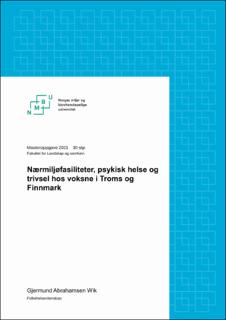| dc.contributor.advisor | Aamodt, Geir | |
| dc.contributor.advisor | Pedersen, Ingeborg | |
| dc.contributor.author | Wik, Gjermund Abrahamsen | |
| dc.coverage.spatial | Norway | en_US |
| dc.date.accessioned | 2022-04-08T10:14:14Z | |
| dc.date.available | 2022-04-08T10:14:14Z | |
| dc.date.issued | 2021 | |
| dc.identifier.uri | https://hdl.handle.net/11250/2990734 | |
| dc.description.abstract | Bakgrunn: Tema i denne masteroppgaven er nærhet til fasiliteter og servicetilbud og sammenheng med psykisk helse og trivsel hos voksne i Norge. Nærområder og dets innhold har nær sammenheng med folks opplevde psykiske helse og trivsel samtidig som Norge bruker mest økonomiske midler på nettopp psykiske lidelser av alle sykdomsgrupper. Det foreligger et stort fagområde som bør tas med i det systematiske folkehelsearbeidet for å oppnå enda mer bærekraftige og helsefremmende samfunn gjennom styrking av nærmiljøet og gruppeprosesser.
Formål: Målet med oppgaven er å få økt kunnskap om sammenhengen mellom nærmiljø og tilhørende fasiliteter og selvopplevd psykisk helse og trivsel hos voksne i Norge. Ved å få mer kunnskaper om områdene kan vi utvikle nærmiljøer som virker attraktive og helsefremmende for befolkningen.
Metode: Studiedesignet for oppgaven er en tverrsnittstudie som tar utgangspunkt i datasett fra to ulike kilder. Selvrapporterte data fra befolkningen i spørreskjema ble koblet sammen med data som beskriver forekomsten av de ulike fasilitetene kino, bibliotek, svømme- og idrettshall, butikker, spisesteder og offentlige transportmidler. Spørreskjemadata er hentet fra Folkehelseinstituttets fylkeshelseundersøkelse for Troms og Finnmark, mens øvrige data er generert ut fra innhentet data gjennom Google maps og kommunene i regionen Troms og Finnmark. Det ble benyttet statistiske metoder og lineære regresjoner i analysene.
Hovedfunn: Resultatene viser at det er en sammenheng mellom opplevelse av trivsel og psykisk helse og enkelte fasiliteter.
Konklusjon: Resultatene i masteroppgaven tilsier at utvikling av nærområder bør hensynta fasiliteter og servicetilbud som tilbys befolkningen, spesielt de som anses som sosialiserende, inkluderende og aktivitetsskapende på ulike nivåer. Jo flere som bor i et tettsted jo viktigere anses dette å være, samt tilknytning for offentlig transport for å kunne benytte seg av tilbudene. For å oppnå best mulig utnytting av attraktive og sentrale områder til dette formålet anses det som essensielt å ha en tverrfaglig tilnærming hvor ulike aktører som planleggere, folkehelsevitere og utbyggere samarbeider godt. | en_US |
| dc.description.abstract | Background: The theme of this master's thesis is proximity to facilities and services and connection with mental health and well - being among adults in Norway. Neighboring areas and their content are closely related to people's perceived mental health and well-being, at the same time as Norway spends the most financial resources on mental disorders of all disease groups. There is a large subject area that should be included in the systematic public health work to achieve even more sustainable and health-promoting societies through strengthening the local environment and group processes.
Purpose: The aim of the thesis is to gain increased knowledge about the connection between the local environment and associated facilities and self-perceived mental health and wellbeing among adults in Norway. By gaining more knowledge about the areas, we can develop local environments that are attractive and health-promoting for the population.
Methodology: The study design for the thesis is a cross-sectional study based on data sets from two different sources. Self-reported data from the population in the questionnaire were linked to data describing the existence of the various facilities cinema, library, swimming- and sports hall, shops, restaurants and public transport. Questionnaire data are taken from the National Institute of Public Health's health survey for the county of Troms and Finnmark, while other data are generated from data obtained through Google maps and the municipalities in the Troms and Finnmark region. Statistical methods and linear regressions were used in the analyzes.
Main findings: The results show that there is a connection between the experience of wellbeing and mental health and certain facilities.
Conclusion: The results of the master's thesis indicate that the development of local areas should take into account the facilities and services offered to the population, especially those that are considered socializing, inclusive and activity-creating at various levels. The more people who live in a settlement, the more important this is considered to be, as well as the connection to public transport in order to be able to use the offers. In order to achieve the best possible utilization of attractive and central areas for this purpose, it is considered essential to have an interdisciplinary approach where various actors such as planners, public health scientists and developers work well together. | en_US |
| dc.language.iso | nob | en_US |
| dc.publisher | Norwegian University of Life Sciences, Ås | en_US |
| dc.rights | Attribution-NonCommercial-NoDerivatives 4.0 Internasjonal | * |
| dc.rights.uri | http://creativecommons.org/licenses/by-nc-nd/4.0/deed.no | * |
| dc.title | Nærmiljøfasiliteter, psykisk helse og trivsel hos voksne i Troms og Finnmark | en_US |
| dc.title.alternative | Local environmental facilities, mental health and well-being among adults in Troms and Finnmark | en_US |
| dc.type | Master thesis | en_US |
| dc.description.localcode | M-FOL | en_US |

